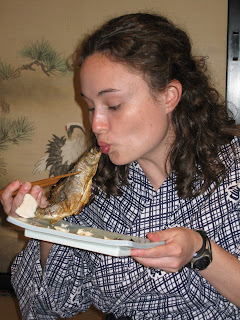Nyuoto Spa and Mt Komagotake

In the beginning of June we ventured south about 80 miles for our anniversary to visit an onsen (hot spring). These hot springs are very popular in Japan and very numerous due to the high volcanic activity of the country. Supposedly they can treat particular ailments (arthritis, heart disease, etc) depending which one you visit. They can be situated in or outdoors, and usually have some degree of sulfur smell to them. The onsen that we stayed at was formerly samurai living quarters in the southern portion of Towada-Hachimantai National Park near Lake Tazawa (above pic - Lake Tazawa-ko is a crater lake, situated almost in the center of the eastern part of Akita Prefecture, and at 423.4 meters in depth is the deepest in Japan.).

Onsen's, like so many things in Japan, have their own rules of etiquette. Before you enter an onsen you're supposed to bathe. There are usually a set of bowls, some soap/shampoo dispensers, and a tub and/or water faucet (you must provide your own at some onsens). When you bathe you're not supposed to stand up, so there are little wood or plastic stools for you to sit on. You dip your bowl into the onsen for hot water and give yourself a shower/bath. After you bathe you can then enter the onsen. Although some onsens allow you to wear a bathing suit, most require you to be in the buff...as much as I like watching a bunch of naked old men, you could imagine why it's not the most desirable place for me to go.

Most onsens are divided into male and female sections, but some have a coed section as well. In these you can enter the water in your respective male/female section then make your way to the main pool. The water itself is usually very hot...warmer than your typical bath or hot tub. I couldn't stay in more than a few minutes at a time. Most of the time the water will be a milky white color, but there are clear and even black water springs. Most of the Japanese will put there towel on top of their head while sitting in the water (supposedly this keeps them cooler?). After you have adequately soaked yourself, there is usually a small dressing room near the spring for you to dress.

The room we stayed in was a traditional style Japanese tatami mat room. There was no bed or kitchen table, so we ate and slept on the floor (see video).

Our dinner was brought up to us and consisted of Japanese soup, noodles, vegetables, and the fish you see in the picture (head, tail, skin and bones). The man that brought our dinner up also set up our futons...it's a good thing, because we had no idea where we were going to sleep.

The next day we hiked to the top of Mount Komagotake. Although it was early June, there was still some snow on the trek. During winter we had skied on many of the neighboring mountains, so it was neat to see them not covered in snow.

Mt. Komagotake, like all other mountains in Japan, is volcanic. It actually consists of three different peaks. We climbed two of them, the tallest just over 5300 feet. We had awesome weather as you can see by the blue skies. The views were great the whole hike, not just the peak (see video). We will definitely be doing more hiking in this area.





0 Comments:
Post a Comment
<< Home